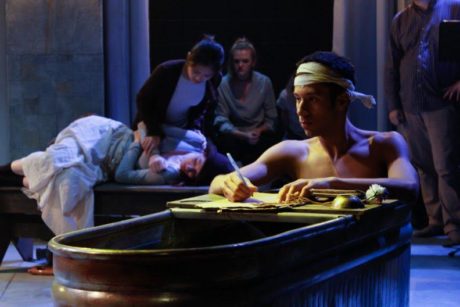The Persecution and Assassination of Jean-Paul Marat as Performed by the Inmates of the Asylum of Charenton Under the Direction of the Marquis de Sade is perhaps the world’s longest title for a play, but it tells exactly what it is about. The Marquis de Sade, the sex driven author for whom “sadism” is named, actually did write and direct plays when he was confined to an insane asylum in the early 19th century. German author Peter Weiss has taken this historical fact and woven it into a bizarre 20th century masterpiece.
In Weiss’ imagination, Jean-Paul Marat becomes the idealistic hero of the French Revolution, which quickly devolves into an uncontrolled bloodbath. Sade, on the other hand is a great individualist, who believes that the natural evil of man will overcome any attempt to create an ordered world. The theater experience mixes the theories of Brecht and Artaud with long didactic discussions of human nature, interrupted by juicy slices of theatricality, provided by the inmate’s antics and songs.
The most famous productions, (England, Germany, Poland) were dangerous concoctions that featured directors locking their casts away for months until everyone involved became nearly deranged themselves. Such an approach, which produced frightening and memorable theater, does not lend itself to the 4-week-to-dress system common in America today and is certainly not recommended for tuition-paying college students.
Temple University’s production has much to recommend it on the technical side. Scenic Designer Fred M. Duer has converted the tiny Randall Theater into an appropriate performance space with various platforms, boxes, curtains and movable stairs that effectively allow the full cast to remain onstage for the entire two hours. Costume Designer Elizabeth S. Ennis masterfully captures the period’s conflict of the elegant aristocracy with the pitiful poor of Paris. The “aristos,” nuns, keepers, and lunatics are all well designated.
Lighting Designer Nick Ligon creates a candlelit atmosphere that atmospherically transports from scene to scene. Only the presence of an electric guitar violates the ambience.
Best of all the young cast is Scott Berkowitz as the Herald, who with great vocal and physical skill introduces and guides playgoers through the intricacies of the grotesque presentation.

Jose R. Mangual powerfully states Marat’s case, as a champion of revolution at any price, while asylum owner Coulmier, (Hunter Robinson), is appropriately supercilious as he introduces his inmates. Thor Speeler is able to convey the foppish inanity of Duperret but is unconvincing as the simultaneously demented sex addict. Guillermo Alonzo projects an appealing calm as Sade, but lacks the vocal agility needed to convey his ideology. His descriptions of sadistic executions and sexual frolics fail to endow the powerful imagery of translators Geoffrey Skelton and Adrian Mitchell.
Directors Donna Snow and Macah Coates, have not succeeded in conveying the play’s central premise, that we are in presence of real lunatics. Curtains are pulled with exact timing, and songs are precisely danced by chorus members pretending to be insane. The result is one-quarter Marat/Sade and three-quarters college musical.
The music of Marat/Sade has always been a highlight. This is especially true of the score composed for the British production by Richard Peaslee that has become a staple of English language productions. Productions in other languages have frequently used different scores. Temple’s version is a bizarre hybrid. Half of Peaslee’s version is used with its trumpet heavy orchestration here reduced to mostly piano and electric guitar. The other half features stylistically inconsistent music by Lyell Hintz and Daniel Isun, as well as popular songs about Wal-Mart, and “The Great Mandella” of Peter Paul and Mary fame.
The directors have in fact jettisoned the last quarter of Weiss’ play for a guitar romp reminiscent of the less effective peace rallies of the 60s. The final result is a mind-boggling mash-up that may confuse experienced theatergoers and make younger students encountering Marat/Sade for the first time wonder why the play is considered a masterpiece.
The program gives no credit to Peaslee, Skelton, Mitchell, or Peter Paul and Mary. None of the publicity materials announce this production as an authorized adaptation.
A suggestion to today’s college students: if you perform a modern play under copyright and the auspices of the Dramatist’s Guild, please perform that play and credit the author, translator, and composer. If you wish to be creative, please write your own original play that says what you want to say in the way you want to say it. You can also adapt Shakespeare and Jane Austin. They’ve been around long enough to take it.
Running Time: 2 hours, with no intermission.
Marat/Sade plays through Saturday, November 19, 2016, at Temple University’s Randall Theater – 1301 West Norris Street, in Philadelphia, PA. For tickets, call the box office at (215) 204-1122, or purchase them online.




